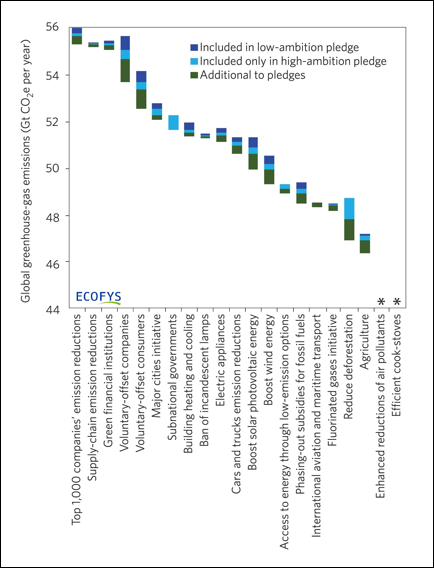
Photo by Kyrylo Kalugin.
The “emissions gap” is the difference between “business-as-usual” greenhouse gas emissions, which continue to rise, and the level such emissions actually need to fall to in order to keep average global warming below 2 degrees C (3.6 degrees F) — the goal that was internationally agreed to at the Cancun climate talks in 2010.
To keep warming below that level, we’d have to have achieved a cut of 12 billion tonnes of greenhouse gas emissions by 2020. That’s the gap we must bridge.
In spite of the tremendous effort by the United Nations Framework Convention on Climate Change Secretariat, negotiations to start reducing global greenhouse gas emissions are going through a difficult stretch. The negotiations have increasingly turned into “I will only accept limitations on my economy if I’m absolutely sure you will do the same for yours,” obscuring the fact that many emissions reduction measures have multiple benefits. Attention is shifting to a treaty that takes effect from 2020, and the country commitments for the period 2012-2020 would close half of the gap, at the very best.
So how do we bridge this gap? There are plenty of realistic steps we can take. At least a third of them involve energy efficiency. And many of these measures have environmental and economical benefits, beyond their reduction of greenhouse gas emissions. Front-running companies, cities, and individual citizens are taking climate action on their own, demonstrating that the potential and the benefits are real.
As it has become apparent in recent years that top-down approaches alone would not work, many have urged a bottom-up plan. But so far, no concrete proposals for this on a global scale have been put forward.
Our “Wedging the Gap” paper proposes such a bottom-up approach, building on all the rapid developments in technology and implementation and on the great initiatives in many places to bridge the global emissions gap.
It consists of amplifying the actions of front-runners in 21 types of activity by applying them on a large scale, under the leadership of organizations already active in the field.
Bringing together all these initiatives in a grand scheme with a major collective impact will serve as a catalyst for individual action.
We have selected the 21 “wedges” by applying the following criteria:
- Already moving: Ongoing activity, allowing for major scaling up before 2020
- Win-win: Significant additional benefits beyond reduction of greenhouse gas emissions
- Leadership: There are organizations that can lead a global initiative
- Impact: The initiative has the potential to reach an emissiosn reduction in the order of 0.5 billion tonnes of CO2-equivalent by 2020
Worldwide, over 30 leading companies have entered into Climate Savers agreements with the World Wildlife Fund, reducing their emissions significantly below business-as-usual. Many of them found that doing so was easier than expected, cost less, reduced their exposure to energy price risks, and helped build their reputation. Together, these companies reduced their CO2 emissions by over 100 million tonnes over the past 12 years.
A recent analysis by Ecofys has shown that taking this approach to major corporations in the 16 business sectors where the program is active could reduce global emissions by 0.5 billion to 1 billion tonnes of CO2 per year by 2020. Many other companies are making similar pledges already — a perfect starting point for a “companies wedge.”
Wind energy has made big strides over the past decades. By the end of last year, 238 gigawatts of installed capacity already provided 2-3 percent of the world’s electricity. The Global Wind Energy Council has published an “advanced scenario,” showing that wind power capacity could grow to 1,070 gigawatts (i.e., a terawatt) by 2020. Doing so would reduce dependence on fossil fuels, improve air quality, and provide an additional emissions reduction of 1.2 billion tonnes of CO2 by 2020, compared to the reference scenario.
Many cities have ambitious climate programs, combining the creation of new cleantech jobs with improvements in housing and infrastructure, lower energy cost, and better air quality. Organizations like C40 and ICLEI are leaders in these efforts. If the 40 megacities in C40, or an equivalent sample of other cities, reduce their emissions to 20 percent below business-as-usual by 2020, this would already result in an emissions reduction of 0.7 billion tonnes of CO2-equivalent.
Add up the total emissions reductions from all 21 of the wedges in our study and you’re cutting 10 billion tonnes from global emissions — which gets us most of the way across the 12 billion-tonne gap.
All wedges are shown in the figure below. Of course, there will be some overlap: Companies and cities may use wind turbines as part of their emission reduction programs. Taking that into account, we estimate the total emission reduction of the first 19 wedges to be 10 billion tonnes of CO2-equivalent per year, achievable by 2020. Adding up the climate benefits of 2 wedges addressing classic air pollutants, including efficient cookstoves in rural areas, would bring us very close to what is needed to keep the world on track for an average global warming of 2 degrees C.





